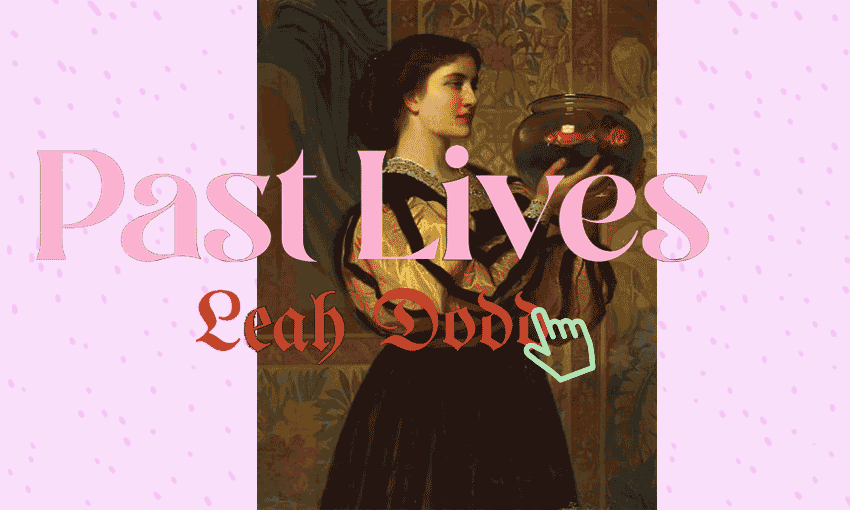How Leah Dodd stumbled upon The Goldfish Bowl by Charles Edward Perugini, and why it ended up on the cover of her debut poetry collection Past Lives.
The process was not dissimilar to the way I decided on my son’s name – I came across something that had the right vibes, then let it slowly grow on me until I wasn’t sure if the feeling was a vaguely profound sense of auspicious destiny, or just the feeling of getting used to something. The painting came to me on the bustling metropolis of the Instagram “explore” page. I was up late, making moodboards (graphic design is my passion) in a struggle to quash the insurmountable fear of producing a first book cover that I might later come to feel didn’t adequately represent the work, and it stood out. Regal woman, billowing no-bullshit sleeves, two glossy goldfish.
I collected pictures of paintings and photographs, trying them against a myriad of typefaces and shades. But despite the brainstorming and mood-boarding and mountains of deep cut memes that I shared, captioned Past Lives 2023, I kept thinking of The Goldfish Bowl. It lived rent-free in my head at all times of day. On the loo, in dreams, in the freshly misted lettuce section of the supermarket. Who was the woman in the painting? Who were the goldfish? How long did she have to hold that bowl up for? Probably ages, she’s not even really looking at them.
It was said that Victorian children could learn more in a few hours of watching goldfish in a bowl than in “many days spent with books”. The fish were placed in velveted and silk-draped parlour rooms, expected to dazzle children or calm the ill, or to be simply gazed at ornamentally by the general eye. I envision them watching goldfish in the way that millennials spend time on the Headspace app, except with less softly-spoken British men. Actually, there were probably lots of those. I see them now, trawling cobbled streets in Victorian summers, peddling luminous bowls of bright orange fish. Drawing them out with a magical glint from where they were inexplicably tucked into dark cloaks and overcoats. How diverting.
Fascinatingly, it was thought that all goldfish needed to survive were invisible insects that lived in the water. The bowl water was changed twice a day, and the goldfish starved to death. Alas! The melancholy! It was all so lavish, so absurd, so clueless. I kinda get it. I did my time as a small-town kid watching two depressed goldfish drift around each other, with names that escape me but were probably something like Sonny and Cher (I asked my sister if she remembered their names and she said “No!”), ribbons of poo twirling behind them in their just-big-enough home on the lounge mantelpiece by the chunky silver TV and murky plastic tank of eternally mysterious Sea-Monkeys®. So lavish.
There is something significant about the way Goldfish Woman is dressed, and the way in which she holds herself – stately and magnificent, yet so detached, and all the while blissfully unaware of how to nurture or even preserve the small lives in her hands. I resonated with that. In the wee hours, I shot up in bed thinking things like “it’s an allegory for transformation! Containment of the self!” I dreamed of gleaming golden sleeves, of planet-sized glass bowls filled with clear water and starving, sparkling fish. The woman had embedded herself into my psyche, vacant stare and bouffant sleeves aplenty. It all started to feel a little bit like Doireann Ní Ghríofa’s A Ghost in the Throat, though with less blood-drinking and bucolic scenes of Ireland.
Past Lives, like The Goldfish Bowl, hides behind blunt extravagance. The poems overshare on description but, in places, keep you at arm’s length (Scorpio sun and rising, make of it what you will). Emotions are laid bare but rarely learned from; wild animals and their relative freedoms are yearned for yet seldom examined at deeper than face value. One might notice a preoccupation with freedoms, transforming bodies, and the repercussions of reproducing in an eco-crisis. Yet, like The Goldfish Bowl, Past Lives is shrouded in a dreamy misguidedness – a superficial calm before an inevitable storm. And so, I chose typefaces. I looked for styles and colours that would represent this dissonance – something that clashed visually and shared the extravagance of those spherical sleeves. Something that didn’t belong but in a, um, cool way. Like the all-caps magenta of Otessa Moshfegh’s My Year of Rest and Relaxation. Hours picking different colours turned into nights, and their code names became muscle memory underneath my fingers until I’d landed on what I felt was perfect.
Past Lives feels like my baby. Books and babies are oft compared, and as I spent nine months concocting both baby and book, albeit not simultaneously, perhaps I am qualified to make this comparison. Both times I felt apprehensive about releasing the respective products into the world. When will this end, with teenagedom? The first time I spot that goldfish painting in a bargain bin?
For now, whenever someone compliments the cover, I feel a strange shot of pride for the goldfish-yielding woman, whoever she may be. I straighten my posture, roll my shoulders back. Conjure magnificence within the evolving limits of what I know.
Past Lives by Leah Dodd (Te Herenga Waka University Press, $25) can be purchased from Unity Books Auckland and Wellington.



